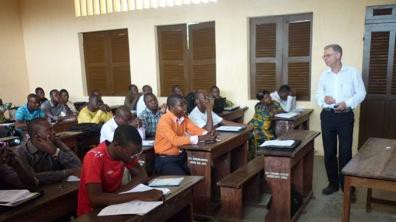Teach computer science in Africa...an enriching experience.

@ Professeur R.D. Hersch
One may ask whether it is useful to teach computer science in Benin, an African country whose gross national product (GNP) per inhabitant is about 1500$ per year (CIA World Factbook), compared to 67’000$ in Switzerland. Over the past years however, an almost exponential increase of the amount of mobile phones in the African Sub-Saharan countries was observed. In each country, many network operating companies exist and new jobs for engineers and administrators have been created. Public administrations and large firms also have important needs in computer engineers.
In 2011, EPFL lecturer Pierre-Yves Rochat received support from the Center for cooperation and development of EPFL (Prof. Jean-Claude Bolay) in order to create an Interschool teaching center for electronics, computer science and telecommunications in Cotonou, Benin.
As a complement to this initiative, we organized a 3 weeks interschool course entitled "Interfaces and Imagery in Java" ("Interfaces et Imagerie en Java" in French). This course was targeted at students who already had knowledge of a programming language, such as Pascal, C, C++ or Java, and who had carried out a project of at least 500 programming lines.
Out of the 60 applications that came from the best institutes of Cotonou, 36 students were selected to start the first part of the course (Introduction to Java). Then, 34 of them were authorized to follow the second part of the course (Interface and Imagery in Java).
This interschool course took place in a teaching room and in a laboratory room which had been rented from a public school. Each day was divided in two parts: teaching (9:00 to 11:30 a.m.), and laboratory (12:00 to 3:30 p.m.). During the laboratory the subject matter taught in the morning was directly exercised.
The first part of the course (7 days) consisted of an introduction to Java and object oriented programming. This first part was taught by 3 voluntary students from the School of Information and Communication Sciences at EPFL, Mr Franck Youssef, Miss Abson Sae-Tang et Mr Foli Gaba.
The second part of the course lasted eight days and was taught by the undersigned. It was focused on interface elements and classes useful for text editing and image manipulation (buttons, text areas, menus, sliders, mouse interaction, image buffers, etc.). The laboratories had the goal of creating simple human interfaces. The last laboratory aimed at assembling the interface widgets developed during the previous laboratories in order to create an interactive editor for extracting and pasting image tiles (see below).

Out of the 34 students who started the second part of the course, 31 students met the requirements to receive a certificate. Half of the students came from the Polytechnical School of the University of Abomey-Calavi (EPAC), a very selective state institution that only retains the best students of the country (same system of preparation classes and entrance exam as in France). The other half of the students came from private, high level teaching institutes. Among the students, some were consultants, and some had a part-time engineering job.
For the next year, other courses may be organized in collaboration with the Beninese NGO "Technologie pour le Développement" founded by Pierre-Yves Rochat and other university teachers from Cotonou. We invite lecturers, PhD students and master students who would like to pursue this effort and teach a two or three weeks course in August/September 2012 to contact the undersigned. The following subjects were asked: client-server systems, applets and Web interfaces, Java for embedded systems (e.g. mobile phones).
The stay in Benin was very enriching. The weekends were dedicated for the visit of very special sites: the lakeside township of Ganvié built entirely on stilts, the city of Porto-Novo with its ancient royal palace and Songhaï centre, a model of sustainable agriculture, as well as the city of Ouidah where 2 millions slaves were sold by the kings of Dahomey, chained and embarked by force on boats leaving for America. On all the sites, the simultaneous presence of churches, mosques and Voodoo worship places gives evidence of the religious fervor of the Beninese people.
Many thanks to all of those who contributed directly or indirectly to the success of this course, in particular the local organizers P-Y. Rochat and Géraud Da-Gbadji ! Note that all expenses, apart from the undersigned' salary, were covered by revenues from know-how transfer and technology licenses to third parties.

Franck Youssef, EPFL student, giving explanations.

Foli Gaba, EPFL student and native from Togo, assisting a participant.

Abson Sae-Tang, EPFL student, assisting a Beninese student.

Professor R.D. Hersch asking a question to the class.